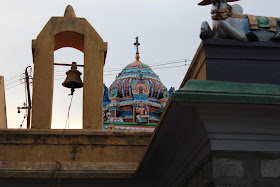Dakshinamurthy Temple (Guru Temple), Govindavadi – The
Temple
Lord
Dakshinamurthy generally has his place on the wall around the main Shiva
shrine. But, this is the temple that has Lord Dakshinamurthy as presiding
deity facing south. Behind is another sanctum separately for Lord
Kailasanathar. Both sanctums are under a single vimana having Lord Shiva
and Lord Dakshinamurthy. Lord Dakshinamurthy is the principal deity of the
temple to whom Aipasi Annabishekam (abishek with rice) in October-November is
performed as to Lord Shiva. The other difference is that Lord
Dakshinamurthy graces with an eye on the forehead and crescent moon as Lord
Shiva himself.
The main
entrance leads to the guru Sannidhi which is a 5 foot statue of
Dakshinamurthy actually situated in the outer wall of the Kailasnathar
Sannidhi alongside. The `kalalam' (the tree canopy above the head of the deity)
is not there and apanchasanam has been carved out below the Muyalagan (the
monster on whom Dakshinamoorthy rests his right
leg). The panchasanam - consisting eight Simhas' (lions), eight
nagams (five-headed snakes), Ashta Dwarapalaka (eight armed guards), eight
Gajas (elephants) and `Ashta dikhbalakas' (regents of eight cardinal points) -
has the Koormam (tortoise) as its base. Though the
Dakshinamoorthy idol has been installed south of the sanctum Santorum of
Sri Kailasanathar (like in any other Siva temple), the construction has been
done in such a way that the deity has a separate shrine.
As he
granted darshan to Lord Vishnu privately, the banyan tree is not here but a
structure (Mandapam) representing Mount Kailash. Muyalagan the
symbol of ignorance usually under the feet of Lord facing right is facing left
in this temple. Vibhuti Kavadi usually attributed to Lord Shiva worship, is
carried for Lord Dakshinamurthy in this temple. The sacred ash is used for
abishek and given as Prasad to devotees. Devotees dissolve it in water and
consume as medicine.
The
panchaloka idol of Dakshinamoorthy is also as exquisite as the granite one. The
deity is seen seated on the Mount Kailash where the Sanakathi sages are
performing penance. Kailasanathar Sannidhi has akhilandeshwari and in
both the Sivan and Amman sannidhis we are allowed very close to the idols. Exquisite
stone carvings - referred to as kumbachara, said to be a form of
sculpting promoted by the Chola Kings.
The
symbol in the forehead of Lord Vishnu is called Namam. This is done with sand
called Thiruman. Here Kumkum and Sandal is used for this
dressing-Alankara to show Vishnu was a Shiva devotee. Bhagwan Adhi
Sankara has a shrine in the temple remembering his visit. Serpent
deities, Rahu and Ketu – also serpent planets – are in a single shrine in the
prakara. Those facing adverse serpent planet effects perform milk
abishek here for relief. The Nagadevata appears with her two legs bent.
Vinayaka is seen a special seat called Avudaiyar.
There
are shrines for Lord Kailasanathar, Mother Akhilandeswari and Lord Chandana Kumkuma
Govinda. Lord Perumal graces from a separate shrine facing
west. Mothers Sridevi, Bhoodevi, Aanjaneyar, Garudazhwar are with
Lord. As Lord Vishnu worshipped Lord Shiva here with his hymns, the place
was originally called Govinda Padi and changed as Govinda Vadi later.
Another
important aspect exclusive to this temple is that devotees, whose marriage
proposals face hurdles because of the influence of Raghu, Kethu or Angaragan,
are allowed to perform Abhishekam to the naga kanni idols installed at the
north-west corner of the temple. After performing the anointment, they
have to worship Dakshinamoorthy to get their marriage proposals through.
















































